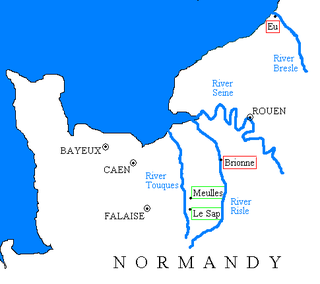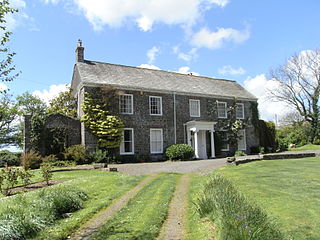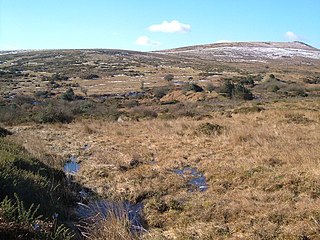
Baldwin FitzGilbert was a Norman magnate and one of the 52 Devon Domesday Book tenants-in-chief of King William the Conqueror, of whom he held the largest fiefdom in Devon, comprising 176 holdings or manors. He was feudal baron of Okehampton, seated at Okehampton Castle in Devon.
Efford is an historic manor formerly in the parish of Eggbuckland, Devon, England. Today it has been absorbed by large, mostly post-World War II, eastern suburb of the city of Plymouth. It stands on high ground approximately 300 feet above the Laira estuary of the River Plym and provides views over long distances: to the north across Dartmoor, to the east and south-east across the South Hams. It consists predominantly of local authority and housing association properties. Before this land was built upon it was known as 'The Wilds of Efford', and was largely unspoilt countryside and marsh land. That a deer park may have been attached to the manor is suggested by the survival of the street name "Deer Park Drive".

Bucks Mills is a small village within the parish of Woolfardisworthy on the north coast of Devon, England. It was anciently the mill of the manor of Bucks, anciently Bokish, Buckish, Bochewis, etc., listed in the Domesday Book of 1086 as Bochewis. The village is within the North Devon Coast Area of Outstanding Natural Beauty and on the South West Coast Path.
Milton Damerel is a village, parish and former manor in north Devon, England. Situated in the political division of Torridge, on the river Waldon, it covers 7 square miles (18 km2). It contains many tiny hamlets including Whitebeare, Strawberry Bank, East Wonford and West Wonford. The parish has a population of about 450. The village is situated about 5 miles (8.0 km) from Holsworthy, 13.081 miles (21.052 km) from Bideford and 22.642 miles (36.439 km) from Barnstaple. The A388 is the main road through the parish.

Huish is a small village, civil parish and former manor in the Torridge district of Devon, England. The eastern boundary of the parish is formed by the River Torridge and the western by the Rivers Mere and Little Mere, and it is surrounded, clockwise from the north, by the parishes of Merton, Dolton, Meeth and Petrockstowe. In 2001 the population of the parish was 49, down from 76 in 1901.
The Manor of Loxhore was a manor in the parish of Loxhore, North Devon, England.

Collaton St Mary is a village, parish and former manor in Devon, England, situated about 2 miles (3 km) west of the town of Paignton. The village is bisected by the A385 Paignton to Totnes road. The parish is now administered within the unitary authority of Torbay, Devon.
The Manor of Shirwell was a manor in North Devon, England, centred on the village of Shirwell and largely co-terminous with the parish of Shirwell. It was for many centuries successively the seat of two of the leading families of North Devon, the Beaumonts and their heirs the Chichesters of Raleigh, Pilton, both of which families were seated at the estate of Youlston within the manor of Shirwell. The manor house which survives today known as Youlston Park is one of the most architecturally important historic houses in North Devon and exists largely in its Georgian form, but retains many impressive late 17th-century interiors.

The feudal barony of Okehampton was a very large feudal barony, the largest mediaeval fiefdom in the county of Devon, England, whose caput was Okehampton Castle and manor. It was one of eight feudal baronies in Devonshire which existed during the mediaeval era.

The Domesday Book of 1086 lists in the following order the tenants-in-chief in Devonshire of King William the Conqueror:

The feudal barony of Plympton was a large feudal barony in the county of Devon, England, whose caput was Plympton Castle and manor, Plympton. It was one of eight feudal baronies in Devonshire which existed during the medieval era. It included the so-called Honour of Christchurch in Hampshire, which was not however technically a barony. The de Redvers family, first holders of the barony, were also Lords of the Isle of Wight, which lordship was not inherited by the Courtenays, as was the barony of Plympton, as it had been sold to the king by the last in the line Isabel de Redvers, 8th Countess of Devon (1237–1293).

Thuborough in the parish of Sutcombe, Devon, England, is an historic estate, formerly a seat of a branch of the Prideaux family, also seated at Orcharton, Modbury; Adeston, Holbeton; Soldon, Holsworthy; Netherton, Farway; Ashburton; Nutwell, Woodbury; Ford Abbey, Thorncombe, all in Devon and at Prideaux Place, Padstow and Prideaux Castle, Luxulyan, in Cornwall. The present mansion house, comprising "Thuborough House" and "Thuborough Barton", the north-east block, is a grade II listed building.

Washfield is a village, parish and former manor in Devon, England, situated about 2 miles north-west of Tiverton. The parish church is dedicated to St Mary the Virgin. It was within the jurisdiction of the historic West Budleigh Hundred.

Lyneham in the parish of Yealmpton in Devon, is an historic estate. The surviving grand mansion house known as Lyneham House is a grade I listed building. It was built c.1699-1703 by Sir Courtenay Croker, MP for Plympton Morice in 1699. A drawing of Lyneham House dated 1716 by Edmund Prideaux (1693–1745) of Prideaux Place, Padstow, Cornwall, survives at Prideaux Place. It shows formal gardens in front with flanking pavilions and an orangery.
Alfred the Breton was one of the Devon Domesday Book tenants-in-chief of King William the Conqueror. He had 22 landholdings in the county of Devonshire held in-chief according to the Domesday Book of 1086, and held further lands as a mesne tenant, including the manor of Panson in the parish of St Giles-in-the-Heath. His manors later descended to the feudal barony of Plympton.
Algar was an Anglo-Saxon personal name, frequently mentioned in the Domesday Book of 1068. it is impossible to determine whether the many mentions of the name in that record refer to a single person or to several people of the same name. Some mentions of the name have an identifying suffix, such as "Algar Long" and "Algar the Priest".

Spurway is a historic manor in the parish of Oakford in Devon. It was the seat of the de Spurway family from before 1244 until the mid-20th century. The derelict buildings of Spurway Barton are in a remote location above a wooded combe.

Hareston is an historic estate in the parish of Brixton, about three miles from Plymouth in Devon. The mansion house built during the reign of King Henry VII (1485-1509) burned down partially in an accidental fire at the beginning of the 18th century, and in 1822 the surviving part, the Hall and Chapel, was being used as a farmhouse. It was described by Candida Lycett Green in her 1991 book The Perfect English Country House as: "The most forgotten Manor House Farm In England, untouched for hundreds of years, sits safely, impossible to find, down miles of private sunken lanes which in the spring brim with Campion, Bluebells, Purple Orchids, Primroses, Violets, Speedwell and Stitchwort. Wooded hills rise behind this, the quintessence of an ancient English Manor House".

Spridleston is an historic manor in the parish of Brixton in Devon, England, long a seat of a branch of the prominent and widespread Fortescue family. The ancient manor house does not survive, but it is believed to have occupied the site of the present Spriddlestone Barton, a small Georgian stuccoed house a few hundred yards from the larger Spriddlestone House, also a Georgian stuccoed house, both centred on the hamlet of Spriddlestone and near Higher Spriddlestone Farm.

Bagtor is a historic estate in the parish of Ilsington in Devon, England. It was the birthplace of John Ford the playwright and poet. The Elizabethan mansion of the Ford family survives today at Bagtor as the service wing of a later house appended in about 1700.















